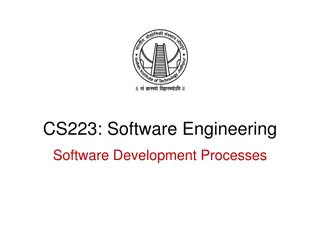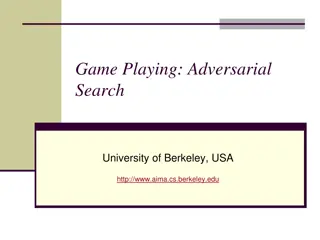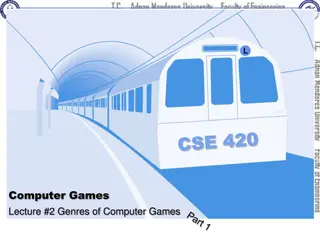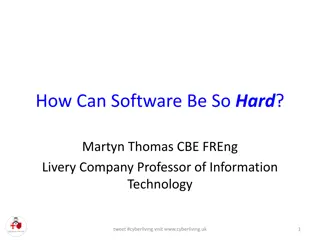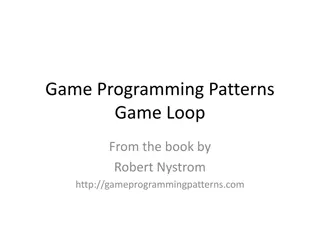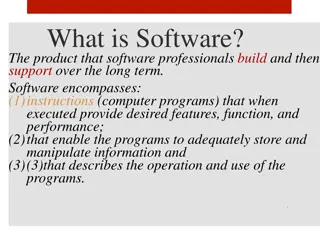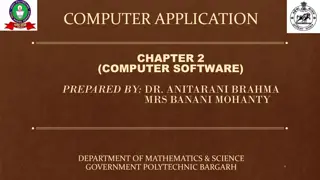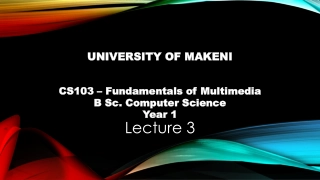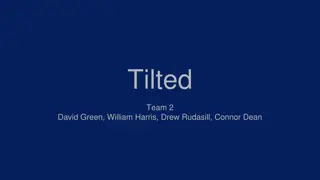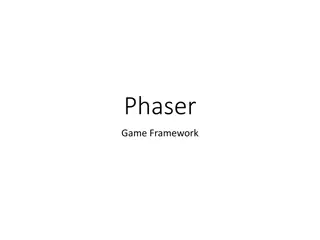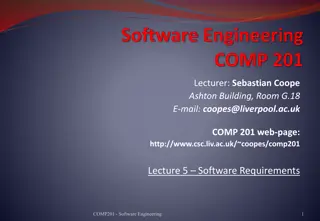Role-Playing in Software and Game Development
Explore the use of role-playing in software and game development processes, leveraging simulations to understand requirements, simulate business scenarios, and engage students in hands-on learning. Discover how role-play enhances communication skills and fosters a deep understanding of complex concepts in interactive games and media education.
Download Presentation

Please find below an Image/Link to download the presentation.
The content on the website is provided AS IS for your information and personal use only. It may not be sold, licensed, or shared on other websites without obtaining consent from the author. Download presentation by click this link. If you encounter any issues during the download, it is possible that the publisher has removed the file from their server.
E N D
Presentation Transcript
Leveraging Role Play to Leveraging Role Play to Explore Software and Game Explore Software and Game Development Process Development Process ADRIENNE DECKER ADRIENNE DECKER, DAVID SIMKINS SCHOOL OF INTERACTIVE GAMES AND MEDIA AND RIT CENTER FOR MEDIA, ARTS, GAMES, INTERACTION AND CREATIVITY (MAGIC) ROCHESTER INSTITUTE OF TECHNOLOGY ADRIENNE.DECKER@RIT.EDU ADRIENNE.DECKER@RIT.EDU, DWSIGM@RIT.EDU
Game Development Processes Software engineering for game developers Emphasis on communication skills and pitch process [FIE 2014 and FIE 2015] School of Interactive Games and Media RIT Center for Media, Arts, Games, Interaction & Creativity MAGIC.RIT.EDU | WWW.RIT.EDU IGM.RIT.EDU
Fall 2015 Addition Role Play Often used to simulate practices in the world in an environment where consequences can be mitigated (military, mock trials, business, psychology). Software engineering process and practice can take months or years We have 15 weeks Role play can allow us to create simulation of situations where consequences can be mitigated, or even forced. School of Interactive Games and Media RIT Center for Media, Arts, Games, Interaction & Creativity MAGIC.RIT.EDU | WWW.RIT.EDU IGM.RIT.EDU
Role Play in the Computing Classroom Engage the student as the user of a technology to understand requirements of the system or how the user would see it (HCI course) [15]. Role play and CRC cards to introduce object-oriented concepts to students [16]. Enterprise Resource Planning course using Second Life as mechanism for enabling the role play and interactions where students are employed by a fictional company [18]. Project management course uses online system for simulation of students acting as project manager and seeing consequences of their decisions [24, 25, 26, 27]. Requirements engineering course using students to play the roles of both the customer and developer to see the multiple perspectives of the process [28]. School of Interactive Games and Media RIT Center for Media, Arts, Games, Interaction & Creativity MAGIC.RIT.EDU | WWW.RIT.EDU IGM.RIT.EDU
Semester Narrative The students are now employee-owners of an independent game studio. The original owners have left with products in production and the employees have now taken ownership of the company. The company has enough money to stay afloat until the end of the calendar year (the end of the semester), but must get products out the door before then to ensure financial viability into the new year. School of Interactive Games and Media RIT Center for Media, Arts, Games, Interaction & Creativity MAGIC.RIT.EDU | WWW.RIT.EDU IGM.RIT.EDU
Emerging Themes Before class: research trends in game industry In class: Identify trends applicable to company s new products Constraints: Budget - no budget for the company to invest in new software or hardware Time release by end of the year (3 months) Skill constraints of the personnel they had on hand the skills of the students in the class School of Interactive Games and Media RIT Center for Media, Arts, Games, Interaction & Creativity MAGIC.RIT.EDU | WWW.RIT.EDU IGM.RIT.EDU
Business Issues Discussion around business law and business practices Incorporating a business Should we change the structure of our company Investors and raising capital Investor pitches School of Interactive Games and Media RIT Center for Media, Arts, Games, Interaction & Creativity MAGIC.RIT.EDU | WWW.RIT.EDU IGM.RIT.EDU
Marketing Products currently in production (former student projects) Before class: Familiarize themselves with the products In-class: Create a marketing campaign for the current products with the idea that a successful launch of these products sets up the launch of the new products in production and the success of the company. Where to market How to market School of Interactive Games and Media RIT Center for Media, Arts, Games, Interaction & Creativity MAGIC.RIT.EDU | WWW.RIT.EDU IGM.RIT.EDU
Software Development Methodologies Students presented on various software development methodologies (waterfall, scrum, agile) to try to convince the studio to adopt that methodology After all presentations, group discussion about which methodology would be adopted by the studio going forward School of Interactive Games and Media RIT Center for Media, Arts, Games, Interaction & Creativity MAGIC.RIT.EDU | WWW.RIT.EDU IGM.RIT.EDU
Legal Crisis In class students were presented a scenario about a legal concern for the company and needed to craft appropriate responses Intellectual Property issue with product currently in production and ready for release Contract and scope creep Possible security breach and a competitor is advertising release of a game very similar to one currently in production School of Interactive Games and Media RIT Center for Media, Arts, Games, Interaction & Creativity MAGIC.RIT.EDU | WWW.RIT.EDU IGM.RIT.EDU
Next Great Idea Ideation and pitches for the next products to go into production School of Interactive Games and Media RIT Center for Media, Arts, Games, Interaction & Creativity MAGIC.RIT.EDU | WWW.RIT.EDU IGM.RIT.EDU
Postmortems Postmortem presentation about the current products in the pipeline Engaged in a group discussion about which projects should move forward and which projects need to be pulled Risk/gap analysis on the company s product base to help make the decisions Students determined how to move personnel from one project to another based on the cuts School of Interactive Games and Media RIT Center for Media, Arts, Games, Interaction & Creativity MAGIC.RIT.EDU | WWW.RIT.EDU IGM.RIT.EDU
Observations Students were positive in their opinion of the inclusion of the role play in the curriculum Open-ended nature of the role play Social interaction that came with working in teams No majority opinion on which interventions had been most effective Instructor s level of engagement was a significant factor in success of intervention Reinforces Vold and Yayilgan s work [17] Universally encouraged our inclusion of these exercises in future iterations of the course School of Interactive Games and Media RIT Center for Media, Arts, Games, Interaction & Creativity MAGIC.RIT.EDU | WWW.RIT.EDU IGM.RIT.EDU
Future Directions New exercises (more business and legal, more focused software methodology, more deliverables) Debriefs Information about what students learned from activities explicitly Video recording of in-class exercises Analysis of video recordings School of Interactive Games and Media RIT Center for Media, Arts, Games, Interaction & Creativity MAGIC.RIT.EDU | WWW.RIT.EDU IGM.RIT.EDU






